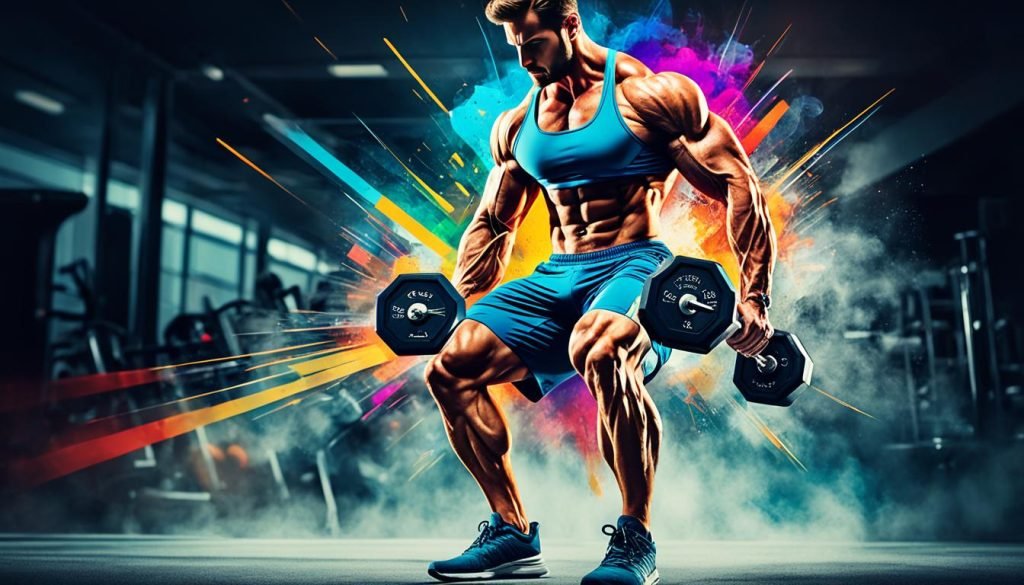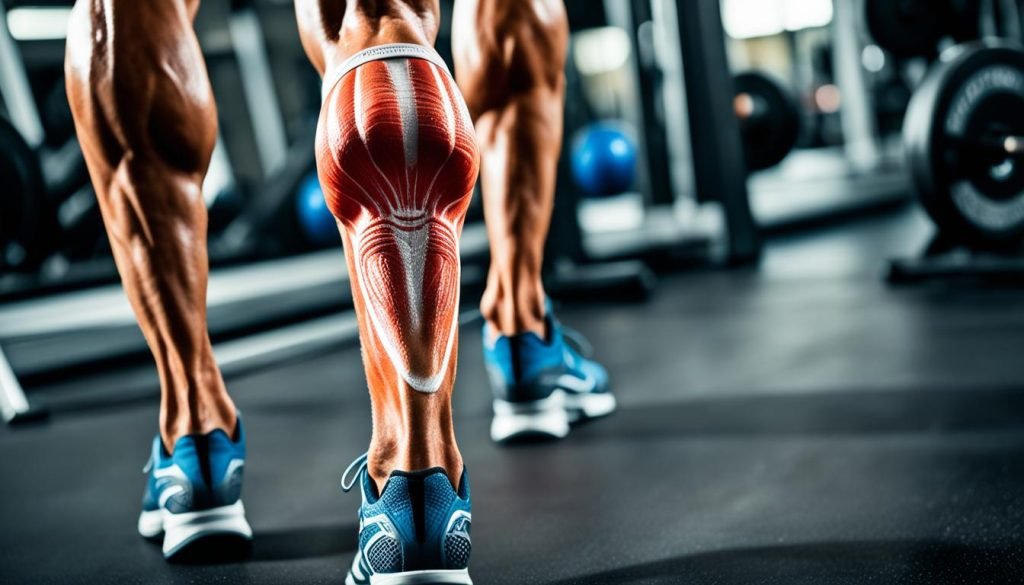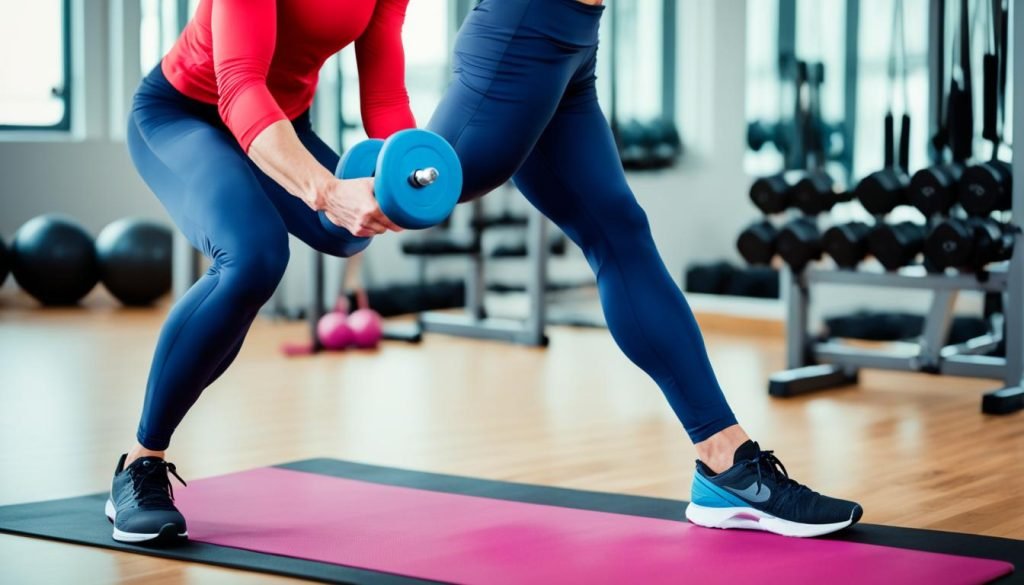What if the secret to your dream physique is in your legs? The path to a successful legs transformation is both rewarding and challenging. It requires focus on specific leg workouts. Understanding the importance of sculpting your lower body is key, not just for looks but for your overall fitness.
This guide will give you the basics of effective leg workouts. It will motivate you to live an active life that makes your legs stronger and healthier.
Key Takeaways
- The importance of setting achievable goals for your legs transformation.
- Leg workouts are essential for boosting your metabolism and promoting fat loss.
- Daily functional movements improve significantly with stronger legs.
- Balancing different muscle groups is key to optimal performance.
- Understanding muscle conditioning, including calf and quad development, is vital.
- Hamstring conditioning contributes to a balanced legs transformation.
The Importance of Leg Workouts for Overall Fitness
Leg workouts are key to getting fit. They make the lower body stronger and help with losing fat and boosting metabolism. Adding leg exercises to your routine can greatly improve how you feel physically.
Boosting Metabolism and Fat Loss
Leg exercises work out big muscle groups in your body. This means you burn more energy, which helps with losing fat. Having a faster metabolism means you use calories better, even when you're not moving.
This can lead to better weight control over time. Regular leg workouts can make your metabolism faster, helping you stay at a healthy weight.
Improving Daily Functional Movements
Strong legs are important for everyday tasks. Doing exercises that make your legs stronger helps with walking, climbing stairs, and standing up. This is key to staying independent as you get older.
Working out your legs often also makes you move better and lowers the chance of getting hurt. This leads to a healthier life.
| Benefit | Description | Impact |
|---|---|---|
| Fat Loss | Engaging large muscle groups boosts calorie expenditure. | Promotes sustainable weight management. |
| Metabolism | Increases metabolic rate through regular training. | Enhances overall energy efficiency. |
| Functional Movements | Strengthens legs for daily activities. | Reduces injury risk and aids in mobility. |
Understanding the Legs Transformation Journey
Starting a journey to transform your legs takes planning and hard work. It's important to set goals that are achievable and push you forward. First, look at your current fitness level. Then, set goals that challenge you but also keep you excited.
Setting Realistic Goals
When setting goals, think about what you want to achieve and when you want to do it. Keep these points in mind:
- Current fitness assessment: Check where you are to set a starting point.
- Measurable outcomes: Choose clear changes like bigger muscles or better endurance.
- Time frame: Have goals for both the short and long term to stay motivated.
- Flexibility: Be ready to change your goals as you see your progress.
Tracking Progress Effectively
It's key to track your progress to stay focused and motivated. Here are ways to measure your growth:
- Body measurements: Take regular measurements of your thighs, calves, and other key areas.
- Performance metrics: Keep an eye on how much you can lift and your endurance in workouts.
- Routine assessments: Check in with yourself every few weeks to see if your goals need adjusting.

Setting milestones in your journey can really help keep you going. This approach makes you more accountable and gives you a clear path to reach your goals.
| Goal Type | Example | Timeline |
|---|---|---|
| Muscle Gain | Increase thigh circumference | 3 months |
| Endurance Improvement | Run 5K without stopping | 6 weeks |
| Strength Increase | Deadlift your body weight | 2 months |
Essential Leg Muscle Building Techniques
To build strong leg muscles, it's key to know the basics of strength training. Focus on sets, reps, and doing exercises right to work your muscles well and avoid getting hurt. This part will give you the basics to make your leg workouts better.
Strength Training Fundamentals
Strength training is the core of building muscles. It uses different methods to make muscles grow and get stronger. Here are the main parts:
- Sets and Reps: Doing 3 to 4 sets of 8 to 12 reps for each exercise is a good plan.
- Proper Form: Keeping the right posture in exercises like squats and deadlifts is key for doing them well and safely.
- Progressive Overload: Slowly adding more weight or resistance makes muscles grow.
Weight Training vs. Bodyweight Exercises
Weight training and bodyweight exercises are both important for building leg muscles. They each have their own benefits that work well together.
| Type of Training | Advantages | Considerations |
|---|---|---|
| Weight Training |
|
Needs the right equipment and technique knowledge |
| Bodyweight Exercises |
|
May need adjustments for high strength levels |
Mixing these methods makes a complete program for building leg muscles. It covers strength and functional fitness. Using both weight training and bodyweight exercises helps build strong leg muscles and boosts overall fitness.
Leg Day Routine: Your Weekly Plan for Success
Adding a structured leg day routine to your weekly workout helps you focus on key muscle groups. It ensures balanced growth and reduces the risk of getting hurt. Here are some leg workouts that target different muscles and boost your performance.
Sample Leg Day Workouts
These leg workouts focus on specific muscles for the best results. Mixing these workouts throughout the week helps develop your legs fully:
- Workout 1: Quads Focus
- Squats: 4 sets of 8-10 reps
- Lunges: 3 sets of 10 reps per leg
- Leg Press: 3 sets of 10-12 reps
- Workout 2: Hamstrings and Glutes
- Deadlifts: 4 sets of 6-8 reps
- Leg Curls: 3 sets of 10-12 reps
- Hip Thrusts: 4 sets of 8-10 reps
- Workout 3: Calves and Agility
- Standing Calf Raises: 4 sets of 12-15 reps
- Seated Calf Raises: 3 sets of 12-15 reps
- Box Jumps: 3 sets of 5-8 reps
Balancing Different Muscle Groups
It's important to balance your workouts to avoid muscle imbalances. Here's a table showing which major muscle groups you're targeting each session:
| Workout Type | Primary Muscle Groups Targeted |
|---|---|
| Quads Focus | Quadriceps, Glutes |
| Hamstrings and Glutes | Hamstrings, Glutes |
| Calves and Agility | Calves, Glutes |

Following a detailed leg day routine helps you work on many muscle groups. Changing up your workouts regularly boosts muscle growth and fitness levels. This ensures your legs are fully trained.
Incorporating Calf and Quad Development
Working on strong calves and quads is key for a better leg look and performance. These muscles help with looks, sports skills, and everyday strength. This part talks about exercises that help grow calf muscles and strengthen quads.
Effective Calf Exercises for Stronger Legs
To get strong calf muscles, you need to do dynamic exercises. Here are some top exercises:
- Calf Raises: Stand on a step's edge, letting your heels drop below the step. Then, raise up to your toes. This targets the gastrocnemius and soleus muscles.
- Seated Calf Presses: Use a leg press machine. Place your feet on the platform, heels on the surface, and push through your toes.
- Donkey Calf Raises: Bend at the waist with your hips up and do calf raises. This isolates the calf muscles while keeping your posture right.
Quad Strengthening Movements
For strong quads, add these exercises to your workout:
- Squats: This exercise works many muscles, focusing on the quads. Make sure your knees are in line with your toes.
- Leg Press: The leg press machine helps control quad work. Adjust the seat for correct alignment and engage your quads during the lift.
- Lunges: Lunges target the quads and improve balance and stability.

Right form and technique are crucial for calf and quad exercises. Doing these exercises right lowers injury risk and boosts muscle growth. A balanced approach leads to better leg performance and a great look.
Hamstring Conditioning: A Key to Balanced Legs Transformation
Hamstring conditioning is key for a balanced lower body. These muscles are crucial for strength, stability, and preventing injuries during workouts. By focusing on hamstring development, you keep your legs balanced, which boosts your performance.
Importance of Hamstrings in Leg Workouts
The hamstrings are vital for leg workouts. They support movements like running, jumping, and lifting. Strong hamstrings help with overall leg strength, making your legs balanced. Conditioning them reduces injury risks and builds a strong base for many activities.
Exercises for Hamstring Development
To boost hamstring development, add these exercises to your routine:
- Deadlifts: This exercise works many muscles, focusing on the hamstrings.
- Hamstring Curls: This targets the hamstrings using machines or bands.
- Romanian Deadlifts: It's a deadlift variation that stretches and contracts the hamstrings.
- Glute Bridges: This exercise strengthens and stretches the hamstrings and glutes.

Adding these exercises to your routine helps with hamstring conditioning. This leads to stronger and more balanced legs over time.
Conclusion
In conclusion, consistent leg workouts are key to better fitness. They help you build the strong legs you want. By doing exercises that focus on different muscles, you can see great results.
We talked about setting goals and tracking your progress. These steps are crucial for your fitness journey. They help you stay on track and see real changes. Also, good nutrition and recovery are vital for your body to heal and get stronger.
Now, you have the strategies and techniques to start your legs transformation. With these tips, you can move forward with confidence. By applying what you've learned, you'll not only get amazing legs but also improve your overall health and fitness.
FAQ
What are the benefits of leg workouts?
Leg workouts boost your fitness by working big muscle groups. This helps burn fat and improve heart health. They also make everyday activities like walking and climbing stairs easier, keeping you independent as you get older.
How do I set realistic goals for my legs transformation?
Start by checking where you are now and set goals that fit your life. Break big goals into smaller steps to keep you motivated and track your progress.
What techniques are essential for building leg muscles?
Key techniques include learning about strength training basics like sets and reps. Also, mix weight training with bodyweight exercises to improve your leg muscles.
What should my leg day routine include?
Your leg day should cover different muscles like quads, hamstrings, calves, and glutes. Don't forget to warm up and cool down to help your muscles recover and perform better.
What are some effective calf exercises?
Good calf exercises are calf raises and seated calf presses. These strengthen your lower legs and help with overall leg strength.
Why is hamstring conditioning important?
Hamstring conditioning keeps your lower body balanced. It boosts leg strength, stability, and lowers injury risk. Deadlifts and hamstring curls are key exercises for hamstring strength.
How can I track my progress in leg workouts?
Track your progress by measuring muscle growth and improving workout performance. Use a workout journal to stay motivated and keep track of your journey.
Source Links
- Transform Your Legs and Glutes with This Ultimate Guide in 2024 | Strong legs, Leg and glute workout, Glutes – https://www.pinterest.com/pin/1022880134107169210/
- How To Get Slimmer Legs In Just 4 Easy Steps – https://letsrelaxspa.com/how-to-get-slimmer-legs/
- 12-Week Plan for Stronger Legs – https://www.oxygenmag.com/workouts-for-women/leg-workouts-for-women/12-week-plan-for-leaner-stronger-legs/
Recent Posts
It's important to evaluate whether Beachbody On Demand continues to meet your fitness needs as we enter 2025. With a range of workout programs and nutrition plans, the platform claims to cater to...
Just like having a personal trainer at your fingertips, Beachbody On Demand offers you an extensive library of on-demand workout programs accessible anytime, anywhere. This service allows you to...

